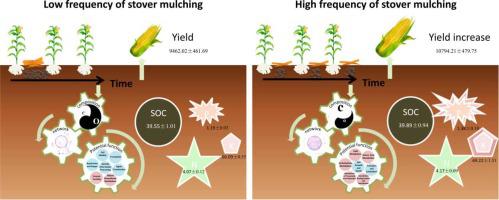Agriculture, Ecosystems & Environment ( IF 6.6 ) Pub Date : 2021-12-13 , DOI: 10.1016/j.agee.2021.107815 Yali Yang 1, 2 , Xuelian Bao 1 , Hongtu Xie 1 , Hongbo He 1 , Xudong Zhang 1 , Pengshuai Shao 3 , Xuefeng Zhu 1 , Yuji Jiang 4 , Chao Liang 1

|
Returning plant residue to farmland maintains or enhances the fertility and productivity of soils to offset degradation of soil quality in cultivated agricultural ecosystems. Although stover mulching serves as a manageable, efficient practice that has been widely used to restore soil health and to sustain ecosystems, it is unclear how changing the frequency and quantity of stover mulching in the long run affects the soil ecosystem, and it remains elusive what the underlying mechanisms are that associated with the features and responses of belowground microbiomes in the process. Here, we investigated a China Mollisol subjected to a 10-year, no-till management scheme with two-level frequencies (i.e., high frequency with continuous mulching per year and low frequency with interval mulching every 3 years) and two-level quantities (i.e., low quantity, 33%, and high quantity, 67%) of maize stover mulching. We found that the frequency, but not the quantity, significantly influenced life-history strategies of bacterial communities and crop yields. Specifically, frequency of stover mulching significantly affected structure of bacterial communities in deeper soil layers at 5–10 cm and 10–20 cm; at 5–10 cm, high frequency of stover mulching showed significantly higher bacterial diversity and richness than low frequency mulching. The complex and close-knit co-occurrence network of bacterial communities in soils under high frequency stover mulching was associated predominately with copiotrophs (e.g., Bacteroidetes and Alphaproteobacteria) and potential metabolic functions that involved carbohydrates, amino acids, and lipids; under low frequency stover mulching, the simple and loose co-occurrence networks were associated with oligotrophs (e.g., Arthrobacter) and potential functions that involved cell processes. We also found that high frequency stover mulching maintained the storage of soil organic carbon, improved the stocks of soil total phosphorus at 16.0% and potassium at 4.7%, and enhanced crop productivity at 14.1% than low frequency, independent of the quantity of stover mulching. Together, we suggest maintaining a low-quantity while high-frequency of mulch might efficiently boost soil health without compromising crop yields and as well optimize the use of stover. Our study revealed that applying a small quantity of stover mulching at high frequency might be sufficient for regenerative agriculture by efficiently improving soil health.


























 京公网安备 11010802027423号
京公网安备 11010802027423号